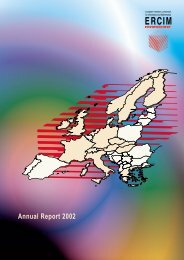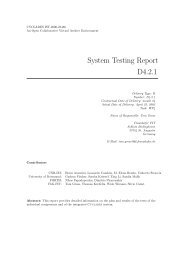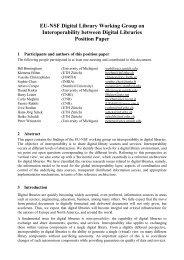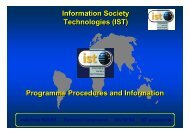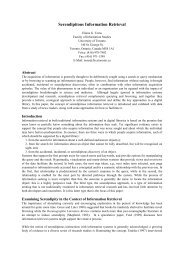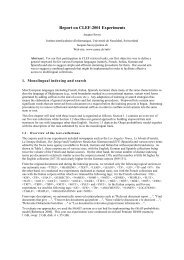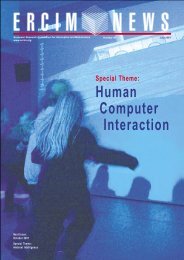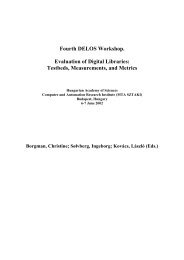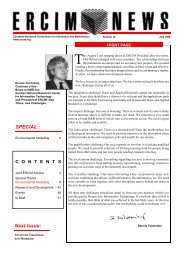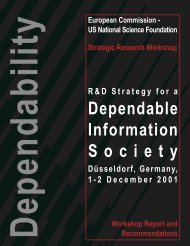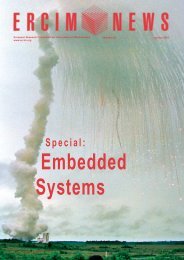Towards a Platform for Widespread Embedded Intelligence - ERCIM
Towards a Platform for Widespread Embedded Intelligence - ERCIM
Towards a Platform for Widespread Embedded Intelligence - ERCIM
You also want an ePaper? Increase the reach of your titles
YUMPU automatically turns print PDFs into web optimized ePapers that Google loves.
2.Europe-specific security and dependability:<br />
Europe has a very specific heterogeneous<br />
culture and history and set<br />
of attitudes to trust and society that<br />
requires specific research profiling.<br />
3.Infrastructure robustness and availability:<br />
Further research ef<strong>for</strong>ts are<br />
needed <strong>for</strong> the assurance of ICT network<br />
and service infrastructures, as<br />
well as the robustness and availability<br />
of critical infrastructure, such as<br />
health, energy, transport or finance.<br />
4.Interoperability: Research on the<br />
interoperability between security and<br />
dependability technologies and standards.<br />
5.Processes <strong>for</strong> developing secure and<br />
dependable systems: Research on the<br />
systematic improvement of secure and<br />
dependable system development<br />
(including hardware and software)<br />
from their design phase.<br />
6.Security and dependability preservation:<br />
In an increasingly complex world<br />
of evolving requirements, technologies<br />
and systems, maintenance of<br />
effective system security and dependability<br />
is critical and is essential <strong>for</strong><br />
preserving user confidence.<br />
7.User-centric security and dependability<br />
standardisation: Strengthen the<br />
structured involvement of end users<br />
and their respective representatives<br />
into relevant standardization activities<br />
involving security and dependability<br />
technologies.<br />
8.Security and dependability of service<br />
oriented architectures (SOA): The<br />
need to establish and maintain trust<br />
and manage policy regulations and<br />
service level agreements in an SOA<br />
context, together with commensurate<br />
advances in software engineering to<br />
deliver service expectations.<br />
9.Technologies <strong>for</strong> security: Research is<br />
needed to provide a higher assurance<br />
of trusted communication and handling<br />
of digital in<strong>for</strong>mation.<br />
Cryptology and trusted functionality<br />
and computing need to be considered.<br />
In addition to these nine key research<br />
areas, four future grand challenges covering<br />
a 10-20 year vision are presented<br />
by the Advisory Board. They illustrate<br />
possible longer-term possibilities and<br />
implications:<br />
1.Countering vulnerabilities and threats<br />
within digital urbanization: This challenge<br />
addresses open problems that we<br />
will face in security and dependability<br />
from the expansion and globalization<br />
of digital convergence by 2010-2015.<br />
2.Duality between digital privacy and<br />
collective security: digital dignity and<br />
sovereignty: This challenge deals with<br />
future privacy issues of all the stakeholders,<br />
whether citizens, groups,<br />
enterprises or states. It addresses the<br />
problem of how to override the 'Big<br />
Brother' syndrome and 'dark security',<br />
ie, the future assurance of digital<br />
sovereignty and dignity <strong>for</strong> the various<br />
stakeholders.<br />
3.Objective and automated processes:<br />
This challenge addresses the problem<br />
of how to attain a controllable and<br />
manageable world of complex digital<br />
artefacts by 2015 and how to inject<br />
regular, quantitative techniques and<br />
engineering to make the field truly scientific.<br />
4.Beyond the horizon: a new convergence:<br />
This last challenge deals with<br />
the preparation of a new convergence<br />
at a horizon of 2020 and beyond,<br />
which is the bio-nano-info-quantum<br />
'galaxy' and the new security and<br />
dependability challenges that will<br />
emerge.<br />
Links:<br />
The full report of the SecurIST Advisory<br />
Board recommendations:<br />
http://www.securitytask<strong>for</strong>ce.eu/<br />
Please contact:<br />
Jim Clarke, Water<strong>for</strong>d Institute of<br />
Technology, Telecommunications Software<br />
and Systems Group, SecurISTCoordinator<br />
E-mail: jclarke@tssg.org<br />
European Research Advances in <strong>Embedded</strong> <strong>Intelligence</strong><br />
The IST Results news service features numerous European<br />
research organisations and industrial partners whose work on<br />
embedded intelligence has been funding under the European<br />
Commission's In<strong>for</strong>mation Society Technologies (IST) R&D<br />
priority.<br />
These research projects focus on many different applications<br />
of embedded systems, <strong>for</strong> example:<br />
• the ASAP project team has produced an open source programming,<br />
analysis and optimisation toolkit <strong>for</strong> pervasive<br />
computing systems using Constraint Logic Programming<br />
(CLP) languages. It has been validated in a series of case<br />
studies and is expected to open the way to more effective<br />
and efficient embedded systems development in the future.<br />
• The <strong>Embedded</strong> WiseNts project has brought together<br />
twelve partners from the top research institutions in wireless<br />
communication, distributed computing and cooper-<br />
EUROPEAN SCENE<br />
ating objects in ten different European countries to focus on<br />
the development of Wireless Sensor Networks (WSN) and<br />
their applications, especially in the <strong>for</strong>m of Cooperating<br />
Objects (CO), to help develop a roadmap <strong>for</strong> innovative<br />
future applications.<br />
• A new technology, dubbed <strong>Embedded</strong> and Communicating<br />
Agents, has allowed researchers at Sony's Computer<br />
Science Laboratory in France to add a new level of intelligence<br />
to a robotic dog. Instead of teaching the dog new<br />
tricks, the algorithms, design principles and mechanisms<br />
developed by the ECAgents project allow the robotic pet to<br />
learn new tricks itself and share its knowledge with others.<br />
For more examples of recent research results related to<br />
embedded intelligence and other current ICT themes, visit<br />
IST Results at http://istresults.cordis.europa.eu<br />
<strong>ERCIM</strong> News No. 67, October 2006<br />
11



